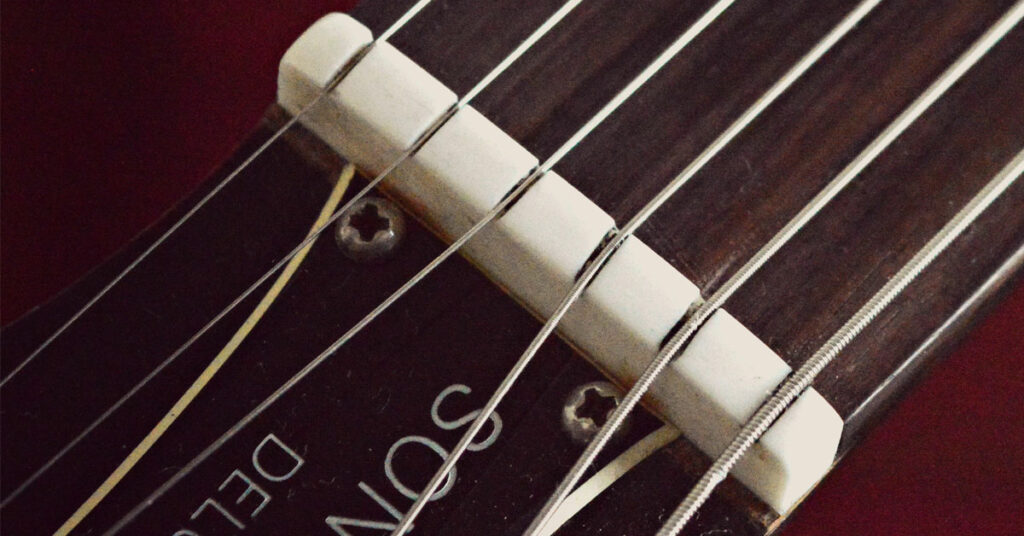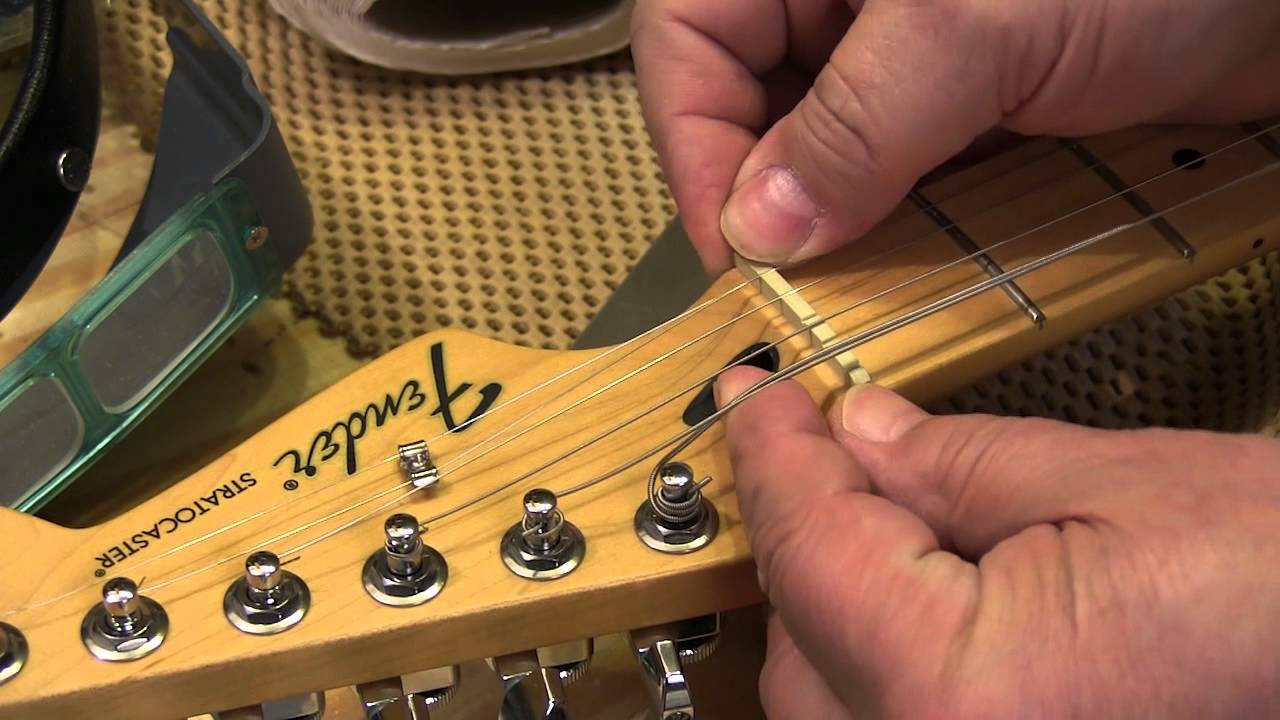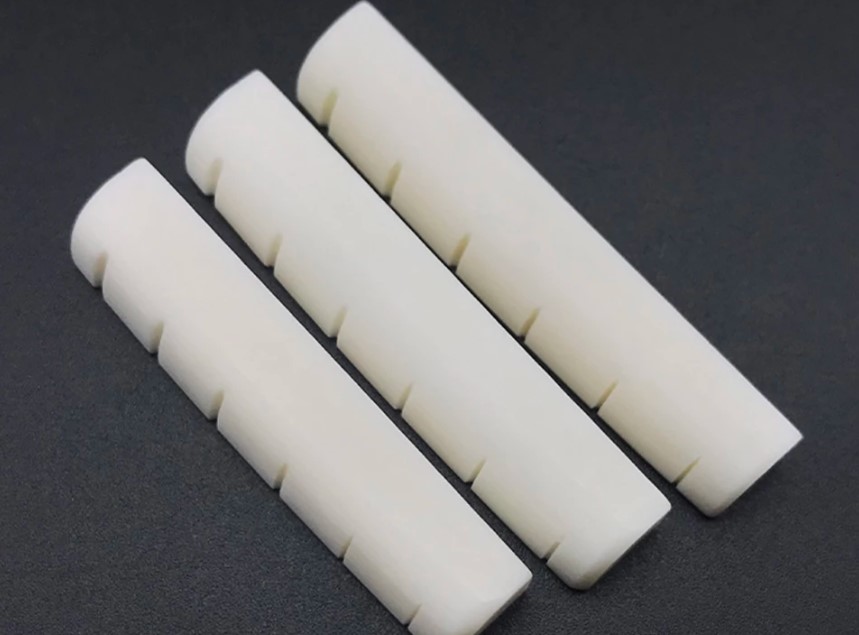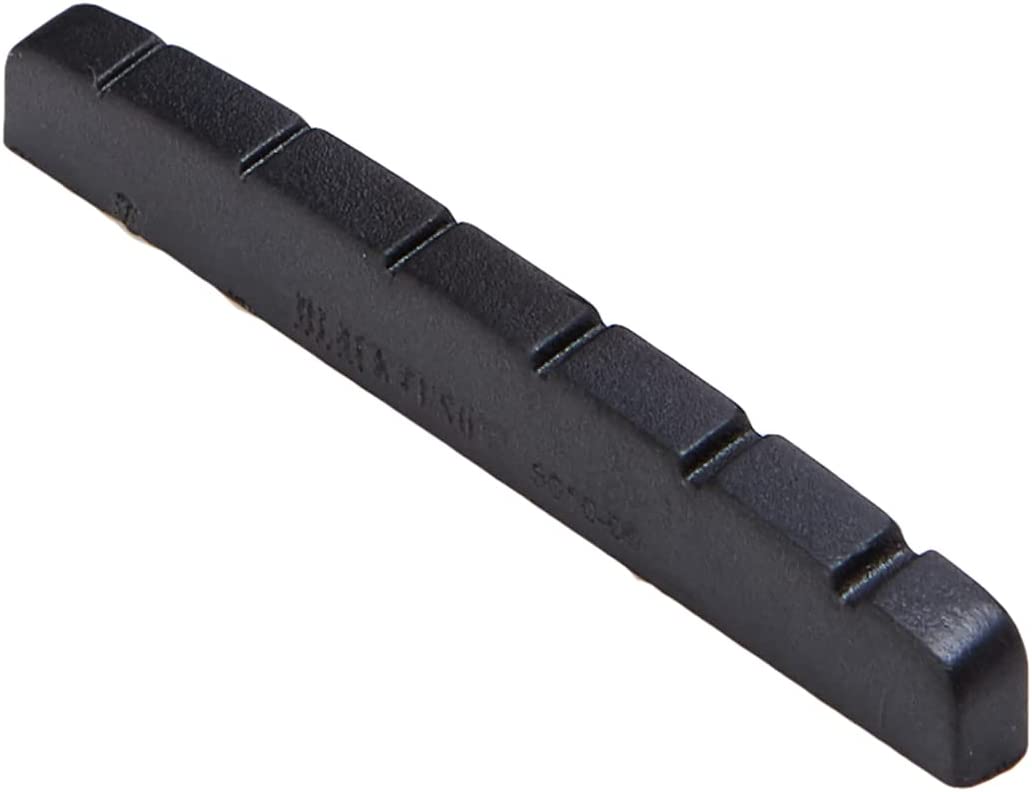Navigating the technical world of guitars can be confusing – when you first decided to buy a guitar, you were probably aware that you would have to deal with technical terms regardings strings, pickups, tonewoods, and tunings. However, I bet you didn’t expect that you’d have to research TUSQ and bone nuts.
If you are anything like me, when I first found out about these technical terms I thought it was a foreign language. It didn’t mean anything to me, yet my guitar teacher told me many times about the importance of comparing TUSQ vs bone nuts. Eventually, I gave into his peer pressure and decided to do some research, and I must say that I learned a ton from the experience.
Luckily for you, you’ve found this guide where I will share everything I learned about comparing TUSQ vs bone nuts, so don’t panic. We’re going to be taking a look at exactly what these terms mean, why they are important, and even some product recommendations. So, if you’re baffled by these words, read on to find out more about them.
Bottom Line Up Front: Regular bone and ivory guitar nuts are made from natural materials and therefore hold inconsistencies in tone and tuning stability, whereas TUSQ nuts are synthetic and therefore are consistently solid throughout. TUSQ nuts such as the Graph Tech TUSQ XL are even self-lubricated, facilitating even higher tuning and tonal stability whilst producing a crisper high and mid frequency range.
The Graph Tech Black TUSQ XL Fender-style Flat Bottom Slotted Nut is a high-tech material for making custom string nuts. The dense Black TUSQ XL material has strong harmonic characteristics such as a clear low end and bell-like highs for bringing your guitar tone back to life. $15.02
$13.66
Main Differences Between TUSQ vs Bone Nuts
The main differences between TUSQ vs bone nuts are:
- TUSQ nuts are made from fully synthetic polymer, whereas bone or ivory nuts are made from natural materials
- Due to their natural material makeup, bone and ivory nuts have inconsistent hardnesses through their nuts, whereas the synthetic nature of TUSQ maintains consistency throughout.
- TUSQ nuts can be self-lubricated in the form of TUSQ XL nuts, whereas bone and ivory nuts must be lubricated manually with nut sauce.
- Bone and ivory nuts are becoming harder to source due to their negative environmental impact and the animals they are sourced from being conserved.
What is a Guitar Nut?

Sorry to disappoint you, but when I refer to TUSQ nuts and bone nuts in this guide, I’m not talking about the edible treats. You may not have come across it before, but guitar nuts are highly important elements of the instrument. Take a look at the top of your guitar just before the first fret, and you should see a small piece of material, a centimeter or two thick and spanning the entire neck – that’s the nut!
Whilst this little piece of material may seem insignificant, it holds two very important roles. The first one is held in the small grooves that you will see in your guitar nut – notice how the guitar strings sit cozily in them. There is a groove for each string, allowing it to sit with optimum tension before spanning the guitar neck and eventually the bridge grooves. Both of these grooves are designed specifically to act as anchor points, otherwise known as ‘saddles’.
These saddles hold the string tightly in place to ensure that it can resonate correctly, preventing them from moving around and affecting the vibrations. Most importantly, these nut grooves prevent strings from touching each other. You may have noticed your guitar strings coming loose from these grooves before, providing a weird fret buzz sound – this illustrates the role of the guitar nut saddles perfectly.
However, this isn’t the only reason that guitar nuts are useful. They also hold a significant role when determining the tone of the guitar. Depending on the material of the guitar nut, the guitar may sound brighter, cleaner, or darker. It may even affect the stability of the guitar tuning.
This is exactly what we are going to talk about today – TUSQ and bone nuts are two different types of nut material, and they dramatically affect the tonal qualities of the instrument. Let’s take a look at exactly what this means for your instrument.
Bone Nuts – What are They?

Now that you understand the purpose of the guitar nut, let’s get down to the more advanced stuff. TUSQ and bone are two different forms of guitar nuts, and they have significant implications for how the guitar sounds. They both have different tones, in addition to different qualities in terms of tuning stability. Tone and tunings are two of the most important aspects of guitar playing, so as you can imagine, this is pretty serious stuff!
Firstly, let’s take a look at bone nuts. Bone is the traditional material used to form the nut of a guitar, as is ivory (the bone that is often found on animals, such as on elephants). Back in the old days, these materials were favored for guitar nuts due to their ability to create deep and rich low frequencies and clear, crisp high frequencies – they simply resonate fantastically.
This was excellent back in the old days when nothing else was available, but there are several disadvantages that these materials hold. For starters, they are natural materials, and whilst this may initially sound like a good thing, natural materials generally come with natural inconsistencies and instabilities. Bone nuts have uneven sustain meaning that different strings resonate in different ways to their neighbors, and softer spots in the material may make the sound even more inconsistent.
The materials are also becoming significantly more difficult to source due to them being derived from animals, and with animals such as Elephants being most common for this, it is often frowned upon due to them being part of preservation campaigns.
The disbenefits of bone nuts don’t stop there though – guitar luthiers often complain when having to work with bone or ivory, due to the prevalence of soft spots in the material that I previously mentioned. Sometimes luthiers will slot the bone nut into the guitar, only to discover that there are soft spots that prevent the instrument from producing the resonant depth that is required.
There’s one final problem with bone and ivory nuts – to produce sufficient resonance, they must be lubricated through nut sauce (it’s not as tasty as it sounds) or graphite. If these nuts are not lubricated, strings can catch in the slots and this can result in a loss of their resonance. Trust me, you don’t want this happening during live performance!
To summarise, bone nuts were favored in the guitar circle for years due to their facilitation of deep, bright, and whole tones, but they hold many disadvantages due to their natural instability and inconsistency. Thankfully, times have changed, and we now have something known as TUSQ. What does this change? Let’s take a look!
Read also: A Guide to Guitar Anatomy – Everything You Need to Know.
Why are TUSQ Nuts Better than Bone Nuts?

Most opinions in the world of guitar gear simply come down to personal preferences – some people prefer acoustics to electrics, some prefer spruce to rosewood, and some prefer steel strings to nylon. However, TUSQ nuts being better than bone nuts isn’t an opinion – it’s just a straight fact.
So, why is this the case? What is so special about TUSQ nuts? Well, there are many reasons for this, but it can all be summarized in a single property – TUSQ nuts are made from a synthetic material, as opposed to the natural materials of bone or ivory. TUSQ was first invented in the ’80s by a man called Dave Dunwoodie, a designer at the guitar gear company Graphtech. It was a synthetic material designed in the form of cutting-edge quality polymer to mimic the tonal qualities that natural materials such as bone and ivory produce.
If you think back to all of the disadvantages that I previously listed about bone and ivory, this should start to make sense. All of these problems such as inconsistent hardness, difficulty to source, inconsistent tones, and the necessity of lubrication can be eradicated by creating the perfect synthetic polymer material, and that’s exactly what Dave Dunwoodie did.
Due to its synthetic nature, TUSQ is reliable, consistent, and holds no natural bioproducts that can negatively impact the guitar sound. Best of all, some TUSQ nuts (such as TUSQ XL nuts) are self-lubricating, and this facilitates the natural tuning stability of bone and ivory without requiring lubrication with nut sauce or graphite.
In many other product cases, synthetic materials mean lesser quality. For example, luthiers prefer to craft cellos, violins, and even guitars out of natural wooden resources, as opposed to synthetic materials such as carbon fiber. However, this is not the case for guitar nuts – nuts benefit greatly from being crafted out of synthetic materials such as TUSQ.
In fact, the benefits of tuning stability and consistency found in TUSQ are so effective that some of the biggest names in guitar production such as Gibson, Tacoma, and Taylor use TUSQ nuts as an industry standard. It really is that good!
What to Look For in a TUSQ Nut
Whether you’re looking to upgrade the bone nut of your current guitar, or you’re searching for a new guitar to purchase and want to prioritize it coming with a TUSQ nut, you’re going to need to investigate the exact TUSQ nut that you will be using.
Thankfully, there are tons of TUSQ nuts on the market, and this can make you feel spoilt for choice. However, this can also be a bit intimidating – what should you look for in the best TUSQ nuts? Are there any particular product properties that you should search for?
There is, and I’d like to quickly summarise them for you. Let’s take a look.
Brand

The first criterion that I have always held when looking into TUSQ nuts for a guitar is the brand. If you’ve read any of my other guitar gear guides, this may come as a surprise to you – I have always held an opinion of “brand shmand”, meaning that sometimes the cheaper and lesser known brands can be hidden gems. Whilst this could still be the case for TUSQ nuts, there is one brand that almost every TUSQ user shops at – Graph Tech.
That’s right – despite them making the first advanced polymer TUSQ nut in the ‘80s, Graph Tech still dominate the industry with their patented TUSQ nut product. Many companies have attempted to pull it off as well as they have, but I am yet to be as impressed with any product as I have been with Graph Tech’s. They dominate the market with their quality, and therefore I would always recommend checking them out first before you look elsewhere.
Number of Grooves
The next important thing to consider is the number of grooves that will be found on a particular TUSQ nut. Back when the TUSQ was first invented, it included six grooves – one for each string of the standard six-string guitar. Each groove holds a string at the head of the neck, providing the resonant benefits of a bone nut but with extra tuning stability.
However, as the TUSQ nut has become more well-known and guitars have grown more complex, there has been an increased demand for TUSQ nuts of different groove quantities. Whilst six-string certainly still dominates the market, you can easily find 4-string TUSQ nuts for bass guitars, seven-string TUSQ nuts for guitarists aiming for a larger pitch range, and even 12-string TUSQ nuts!
It is great to have the innovation of the TUSQ nut applied to so many different string quantities, but this can be confusing if you don’t check the specifications. Always check the string quantity of a TUSQ nut – the last thing you need is to be accidentally buying a four-string or seven-string TUSQ nut for your six-string guitar!
Setup

If you’re looking to buy a brand-new guitar with a pre-installed TUSQ nut, then you can skip this section. However, if you’re looking to purchase an individual TUSQ nut to replace your old bone nut, the setup of your nut is worth considering.
Replacing a nut is nothing to scoff at – sure, it’s not incredibly complicated, but it still involves a certain level of DIY knowledge such as removing the original nut, sanding the new one down, and gluing it into place.
Experienced guitar modifiers will find this process simple, but if you’ve never fiddled with your guitar in such a way, it’s a smart idea to research the setup process in advance. Many TUSQ nut retailers such as Guitar Center will install the nut for you if you bring the guitar to their shop.
If this is not offered, they should at least provide you with detailed instructions on how to install their specific TUSQ nut. Whatever you do, don’t go into this blindly – it’s pretty simple once you’ve done it a few times, but can be a bit daunting if you’ve never dived into guitar DIY before.
Reviews
The final point that I wanted to advise you on when purchasing a new TUSQ nut for your guitar is to read the darn reviews! This is generally good advice for any online shopping – reviews can reveal the level of quality of a product in a non-biased way, with recent customers providing their personal experiences, without any interference from pesky marketers. Positive reviews can provide you with the assurance that you are purchasing a high-quality product, whereas negative reviews can outline problems with the product.
When looking at TUSQ nut reviews, check to see what people think about the resonance and tone that the nut provides – after all, this is the main reason someone would upgrade from a bone or ivory nut! It’s also smart to investigate other more general concerns, such as shipping speed, packaging, and customer service. Remember, not all happy customers leave reviews, but an unhappy customer almost always will!
My Top 3 TUSQ Nut Recommendations
You should now have a solid understanding of what TUSQ and bone nuts are, why TUSQ is generally considered to be better, and what to look for when buying them. However, this isn’t going to make your purchase much easier, there are still many TUSQ nuts on the market and you’ll need to work out which one is best for you.
So, I’ve put together the following three recommendations of products that I think you’ll love. Check them out, maybe they’ll provide you with some inspiration!
Graph Tech PQ-1728-00 TUSQ Nut Acoustic Slotted Nut
The first TUSQ nut on my list of recommendations is a product from Graph Tech, the brand I mentioned earlier which is famous for inventing the TUSQ nut.
As the name suggests, this first recommendation is designed specifically for acoustic guitars, being produced of white polymer to achieve the complex resonance of bone and ivory but without the inconsistencies.
It’s cheap to purchase and comes pre-slotted so that you can quickly install it to your acoustic guitar straight away, and it’s overall a fantastic addition to your DIY acoustic guitar upgrade project.
Pros
- Produced by Graph Tech, the inventor of the TUSQ nut
- Pre-slotted, making for an easy setup
- Has fantastic reviews
- Ideal for upgrading your acoustic guitar
Cons
- Only suitable for acoustic guitars, not electric
The PQ-1728-00 is the perfect option to upgrade the nut on your six string guitar. It is pre-slotted for a quick and simple install. The PQ-1728-00 is also available in a convenient 10 pack (LQ-1728-10).$15.02
$12.77
Graph Tech TUSQ 6 String electric nut 43mm x 6mm
Next on my list is very similar to the previously mentioned product, another product from Graph Tech – the masters of the TUSQ nut! However, as opposed to being designed for acoustic guitars, this bad boy is made for 6-string electric guitars.
You’ll notice that this product has excellent reviews, averaging a rating of 4.5 out of 5 across 89 ratings as of when this was written – that’s impressive! If you’re looking to improve the resonance of your electric guitar (perhaps a Les Paul, or a PRS maybe), this polymer nut is going to do the job fantastically.
The only downside to this product is that if you check the reviews, many people have commented that the setup can be a bit pesky. You’ll likely have to sand down the nut a little to make it fit your specific guitar, but you’ll get there eventually.
Don’t forget to measure your guitar neck too to ensure that the size will fit!
Pros
- Again, you just can’t beat Graph Tech for TUSQ nuts
- Ideal for electric guitar upgrades
- Excellent reviews
- A very reasonable price
Cons
- The setup can be a bit pesky as you’ll need to measure your guitar to ensure it will fit, and sanding the nut may be necessary
One of the key causes of tuning frustration is string binding at the nut. An inexpensive and quick solution to what you need are TREM-NUTS.$15.02
$14.01
Graph Tech Black Tusq XL Flat Bottom Slot Nut PT-5010-00
The final TUSQ nut (and my favorite) recommendation on this list is the Graph Tech Black Tusq XL Flat Bottom Slot Nut PT-5010-00 – that’s right, I’ve chosen Graph Tech for all three of these product recommendations, but their quality standards are simply too high to miss out.
So, what makes this TUSQ nut so much better than the previously mentioned examples? Well, that’s simple – this is a TUSQ XL nut, as opposed to a standard TUSQ nut. This ultimately means that the nut is impregnated with something called PTFE, something that ensures that the nut is permanently lubricated.
As a result, the tuning stability and tone are even better than regular TUSQ nuts, and you’ll be able to perform complex tremolos and other decorations without worrying about your strings becoming unbalanced.
TUSQ XL nuts also have a better mid-range than regular TUSQs – they’re just better pieces of kit in general. I also love that this product comes in black as opposed to the standard white nut, it looks truly fantastic on electric guitars. A 10/10 product, easily.
Pros
- You guessed it, it’s produced by Graph Tech, the kings of the TUSQ nut!
- It’s a TUSQ XL nut, meaning that it is impregnated by PTFE and thus self-lubricated
- Black in color, something that I think looks great on electric guitars
- The TUSQ XL nut has a better mid-frequency range than regular TUSQ nuts
Cons
- Some people do not like their nut to be black, but instead white
The Graph Tech Black TUSQ XL Fender-style Flat Bottom Slotted Nut is a high-tech material for making custom string nuts. The dense Black TUSQ XL material has strong harmonic characteristics such as a clear low end and bell-like highs for bringing your guitar tone back to life. $15.02
$13.66
FAQ
Well, that brings me to the end of my TUSQ nut product recommendations! I hope that I have succeeded in explaining why they are better than traditional bone and ivory nuts. We’ve covered a lot of information today, so let’s finish things up with a quick FAQ to answer any of your burning questions!
Question: What Is a Guitar Nut?
Answer: A guitar nut is a small piece of material placed at the top of the guitar neck with small grooves for each string of the guitar, helping to maintain tuning stability, increase resonance, and prevent strings from touching each other.
Question: What Is the Difference Between TUSQ vs Bone Nuts?
Answer: Bone and ivory nuts are made from natural materials and therefore contain inconsistencies in hardness, tone, and tuning stability, whereas TUSQ nuts are made from synthetic polymers and are therefore more stable in every way.
Question: Which Brand Produces the Best TUSQ Nuts?
Answer: Whilst some other brands produce high-quality TUSQ nuts, Graph Tech is well known for inventing and holding somewhat of a monopoly on the highest quality TUSQ nuts.
Question: What’s the Difference Between TUSQ vs TUSQ XL nuts?
Answer: The difference between TUSQ and TUSQ XL nuts is that TUSQ XL nuts are impregnated with PTFE, a material that facilitates self-lubrication of the nut to improve tuning stability and resonance even further.
Final Thoughts
I hope you learned a lot from this guide to TUSQ vs bone nuts explained! It may initially seem complicated, but as I’m sure you’ve learned by now, it’s not! We’re so lucky to have companies like Graph Tech producing these huge guitar innovations, and I sincerely hope that they continue to produce them.
You simply cannot go wrong with a product such as the Graph Tech Black Tusq XL, I’d recommend it over any other nut out there! Good luck on your journey, and don’t forget to ask for some help in your local Guitar Center if you’re unsure about how to install your TUSQ nut – you’ll find it easy after some expert advice. Cheers!
The Graph Tech Black TUSQ XL Fender-style Flat Bottom Slotted Nut is a high-tech material for making custom string nuts. The dense Black TUSQ XL material has strong harmonic characteristics such as a clear low end and bell-like highs for bringing your guitar tone back to life. $15.02
$13.66
- Where to Sell Guitars Online - August 23, 2023
- How to Find The Most Versatile Electric Guitars - August 22, 2023
- Best Squier Jazz Basses Guide - August 22, 2023







